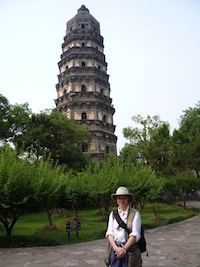Home » HART » Tracy Miller Named Interim Chair of History of Art Department
Tracy Miller Named Interim Chair of History of Art Department
Posted by vrcvanderbilt on Friday, August 24, 2012 in HART, VRC.
 A specialist in the ritual architecture of medieval China, Tracy Miller, associate professor of history of art and former director of the Asian Studies Program, is the new chair of the Department of History of Art for the 2012-2013 academic year. Miller, who joined the Vanderbilt faculty in 2000, teaches courses in East Asian art history and the history of Asian architecture, with special emphasis on the ritual and garden architecture of China and Japan.
A specialist in the ritual architecture of medieval China, Tracy Miller, associate professor of history of art and former director of the Asian Studies Program, is the new chair of the Department of History of Art for the 2012-2013 academic year. Miller, who joined the Vanderbilt faculty in 2000, teaches courses in East Asian art history and the history of Asian architecture, with special emphasis on the ritual and garden architecture of China and Japan.
After completing her bachelor’s degree in art history at Arizona State University, Miller spent two years in China (1991-1993) studying Mandarin and completing graduate coursework in architectural history at Beijing’s Qinghua University. She earned a doctorate from the University of Pennsylvania’s Asian and Middle Eastern Studies program in 2000. Miller lived another three years in Asia (1997-2000) engaging in fieldwork in Hebei and Shanxi provinces and continuing her training in classical Chinese and Japanese. While completing her doctorate, she was a research fellow at Academia Sinica, Taiwan, from 1998 to 2000.
This semester she is teaching History of Asian Art and Architecture: Tradition and Transformation. Her research focuses on the culture of ritual sites in medieval China (618-1644), specifically the ways in which identity was expressed visually through the media of temples and their artistic programs.
This past year Miller was the Rebecca Webb Wilson Fellow and co-directed the Robert Penn Warren Center Faculty Fellows Program, Sacred Ecology: Landscape Transformations for Ritual Practice. The year-long interdisciplinary seminar explored the manifold experiences of complex ritual sites around the world and across all periods of history. Miller and nine other Vanderbilt scholars from a variety of disciplines, including anthropology, classical studies, history of art, Asian studies, history, Latin American studies, and English, grappled with such issues as: How do people interact with landscape? How does it inspire them to create buildings? How do they integrate building structures into the landscape? How do they modify landscape for their own desires and interests in interacting with the divinities that reside at that site?
Her first book, The Divine Nature of Power: Chinese Ritual Architecture at the Sacred Site of Jinci (Harvard University Asia Center, 2007), received the Southeastern College Art Conference (SECAC) Award for Excellence in Scholarly Research and Publication in 2008. Using an interdisciplinary approach drawing on the research of archaeologists, anthropologists, and religious, social, and art historians, Miller sought to recover the motivations behind the creation of art, including temple buildings, sculptures, and wall paintings, within a sacred landscape, addressing the way in which specific temple forms and their placement within the landscape affected the understanding of the identities of divinities worshipped within them.
Miller was meticulous in her in-depth investigation of the dramatic ritual complex of Jinci, near modern Taiyuan, capital of Shanxi Province, with its more than thirty worship halls and subsidiary structures dating from the Song through the Qing dynasties. Built around three sacred springs that feed the Jin River, the complex is renowned for the monumental Sage Mother Hall (ca. 1038-1087), the second largest extant Northern Song dynasty building, the most decorative at the sacred site, and dedicated to the Spirit of the Jin Springs. For the literati elite of late imperial China, however, Jinci was thought to be dedicated to an ancestral figure, the Zhou dynasty lord Shu Yu of Tang and his mother Yi Jiang. By “reading the architecture” and integrating architectural evidence into the site’s 1,500-year-long textual history, Miller demonstrates “how Jinci reflects the interests of the agrarian community and how its architecture was manipulated to assert competing interpretations of the Sage Mother’s identity in order to claim dominance over the site.
 Her current research is for a second book regarding Chinese medieval architecture entitled Building Across Borders: Regional Style in China’s Monumental Timber Architecture 900-1200. Central to her research are the timber bracketing systems that support the roofs of ritual structures. “These buildings and bracket systems are markers of self-awareness and self-confidence in a specific time and place,” said Miller, explaining that her work documents Chinese regional identity that persisted despite new rulers who sought to import styles from other regions. “The style of the bracketing is helpful in tracking the path of architecture and culture as the southeast increased its influence over north central China from the tenth through the thirteenth centuries.” ~Fay
Her current research is for a second book regarding Chinese medieval architecture entitled Building Across Borders: Regional Style in China’s Monumental Timber Architecture 900-1200. Central to her research are the timber bracketing systems that support the roofs of ritual structures. “These buildings and bracket systems are markers of self-awareness and self-confidence in a specific time and place,” said Miller, explaining that her work documents Chinese regional identity that persisted despite new rulers who sought to import styles from other regions. “The style of the bracketing is helpful in tracking the path of architecture and culture as the southeast increased its influence over north central China from the tenth through the thirteenth centuries.” ~Fay

©2025 Vanderbilt University ·
Site Development: University Web Communications